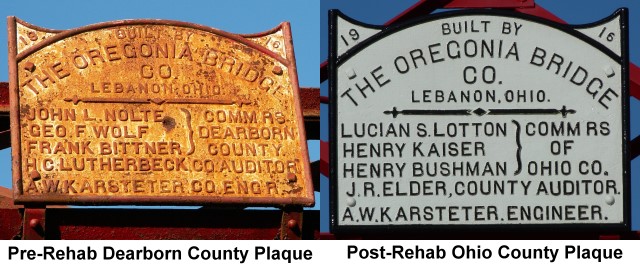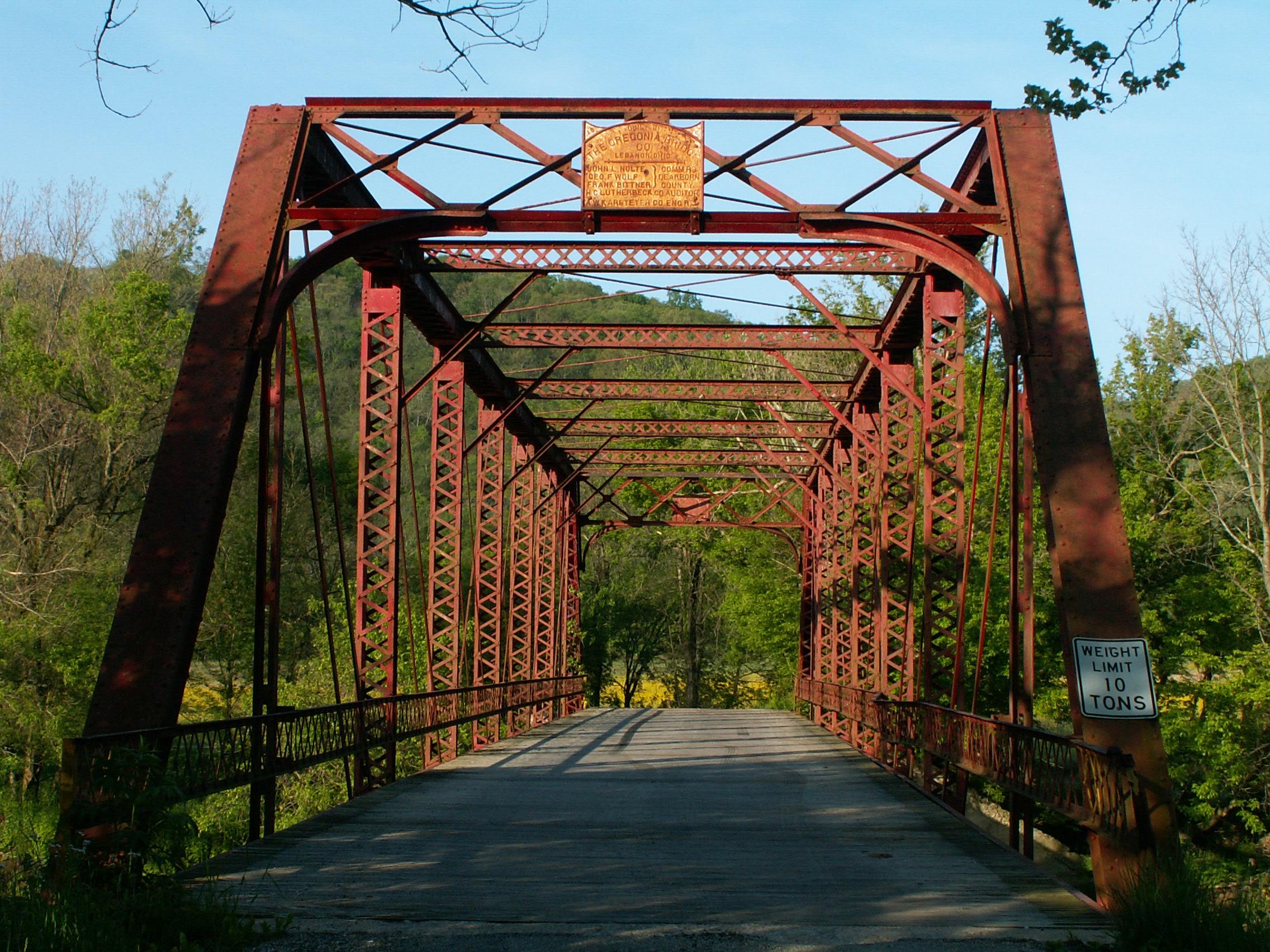We Recommend:
Bach Steel - Experts at historic truss bridge restoration.
BridgeHunter.com Phase 1 is released to the public! - Visit Now
Lost Bridge
Dearborn County Bridge 15, Ohio County Bridge 29

Primary Photographer(s): Nathan Holth and Rick McOmber
Bridge Documented: May 6, 2006
Rural: Dearborn County, Indiana and Ohio County, Indiana: United States
1916 By Builder/Contractor: Oregonia Bridge Company of Lebanon, Ohio
2009
141.7 Feet (43.2 Meters)
147.0 Feet (44.8 Meters)
16.7 Feet (5.09 Meters)
1 Main Span(s)
1500014

View Information About HSR Ratings
Bridge Documentation
View Archived National Bridge Inventory Report - Has Additional Details and Evaluation
This bridge is known locally as the "Lost Bridge."
With a 1916 construction date, this is a relatively late example of a pin connected truss bridge that still looks like it came out of the 1890s. This is a very scenic bridge in a very scenic location and is well worth the drive out here. There is v-lacing on the vertical members and under the top chord / end port, and lattice is on the sway bracing, as well as on the portal bracing. Also, original lattice railings remain on the bridge. Cambria brands are present on the bridge. The deck of the bridge is wooden and the bridge sits on concrete abutments. One unusual thing is that the deck seems like it was higher than usual in relation to the feet of the bridge. It was high enough that a small stringer approach is present at the end to lead to the surface beyond the bridge.
Dearborn County executed a beautiful rehabilitation on this bridge in 2009, and repainted it an attractive bright red that allows the bridge to stand out and be noticed. It is nice to see this commitment to preservation with a rural bridge like this. Often bridges tucked away in rural locations go un-noticed and are not preserved. The bright paint color is a nice change of pace as well, since often preserved historic bridges are painted dark colors that are difficult to photograph and also tend to hide the intricate details of the truss. In contrast, the red paint brings the details of the bridge out. The railings and plaque are painted white, which creates a nice contrast and further develops the sense of detail that one gets from viewing the bridge.

Among the aspects of the work is the requirement that failed rivets be replaced with genuine hot-metal driven rivets, just like the bridge received when built in 1916. Typical highway rehabilitation projects replace failed rivets with historically incorrect modern high strength tension control bolts. Not only do these bolts look ugly (they lack a smooth head on each end) they are alterations that diminish the historic integrity of the bridge. They are used because of the false believe that due to AASHTO and other regulations, the use of rivets in rehabilitation projects for bridges to carry vehicular traffic is forbidden. This is clearly not true, as the Lost Bridge proves.
This project was designed by J. A. Barker Engineering. HistoricBridges.org recommends this firm for any metal truss bridge rehabilitation project. Not only is the firm skilled in designing a project that will not reduce the historic integrity of the bridge, the project will be high quality so as to give a long service life, and will also be more cost effective than a firm that is inexperienced with historic bridges will offer.
The plaques on this bridge are not the same. They each list the county commissioners for the county that the plaque is located in (the bridge is on the county line). Dearborn County apparantly took the lead in having the bridge built
however, since their county engineer appears on both plaques.

Information and Findings From DHPA Historic Bridge SurveyStatement of Significance Designed by a noted Ohio firm as a heavy but quite traditional structure, the bridge retains its original members, including its decoratively latticed portals and guardrails. The placement of the floor-beams above the lower chord and the reliance on heavier structural members are more typical of 20th than of 19th c. Pratt construction. Architectural Description The Oregonia Bridge Company of Lebanon, Ohio,
fabricated this single-span, pin-connected Pratt through truss which is
seated upon concrete abutments and wingwalls. Intermediate verticals of
laced heavy channels subdivide the 146' truss into most of its eight
panels. Eyebars provide the diagonals: pairs of die-forged and
rectangular ones stretch toward center span from the top panel point to
the bottom of all except the endpost panels; cylindrical eyebars with
turnbuckles counter the others in the two most central panels. Riveted
to the verticals above the lower chord, I floor-beams carry the concrete
deck with its 17'6" roadway and 13'8" of vertical clearance. Bridge Considered Historic By Survey: Yes |
![]()
Photo Galleries and Videos: Lost Bridge
Bridge After 2010 Rehabilitation
Original / Full Size PhotosA collection of overview and detail photos. This gallery offers photos in the highest available resolution and file size in a touch-friendly popup viewer.
Alternatively, Browse Without Using Viewer
![]()
Bridge After 2010 Rehabilitation
Mobile Optimized PhotosA collection of overview and detail photos. This gallery features data-friendly, fast-loading photos in a touch-friendly popup viewer.
Alternatively, Browse Without Using Viewer
![]()
Bridge Before 2010 Rehabilitation
A collection of overview and detail photos. Also includes a few post-rehab photos from Melissa Rieman This photo gallery contains a combination of Original Size photos and Mobile Optimized photos in a touch-friendly popup viewer.Alternatively, Browse Without Using Viewer
![]()
Maps and Links: Lost Bridge
Coordinates (Latitude, Longitude):
Search For Additional Bridge Listings:
Bridgehunter.com: View listed bridges within 0.5 miles (0.8 kilometers) of this bridge.
Bridgehunter.com: View listed bridges within 10 miles (16 kilometers) of this bridge.
Additional Maps:
Google Streetview (If Available)
GeoHack (Additional Links and Coordinates)
Apple Maps (Via DuckDuckGo Search)
Apple Maps (Apple devices only)
Android: Open Location In Your Map or GPS App
Flickr Gallery (Find Nearby Photos)
Wikimedia Commons (Find Nearby Photos)
Directions Via Sygic For Android
Directions Via Sygic For iOS and Android Dolphin Browser
USGS National Map (United States Only)
Historical USGS Topo Maps (United States Only)
Historic Aerials (United States Only)
CalTopo Maps (United States Only)



